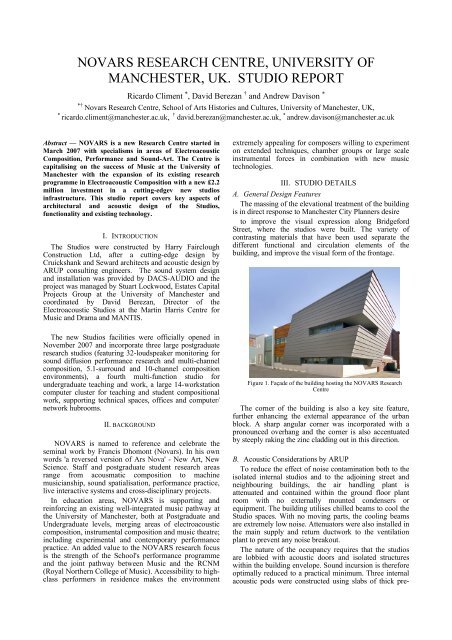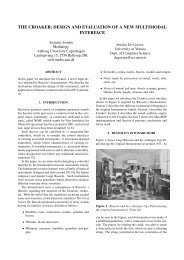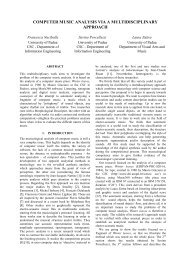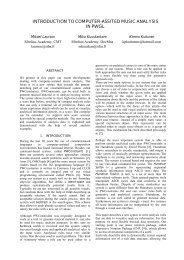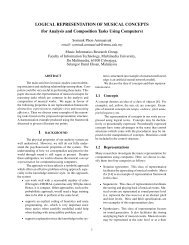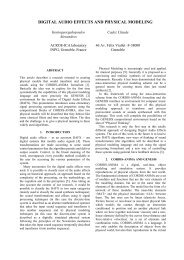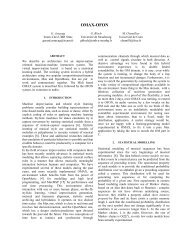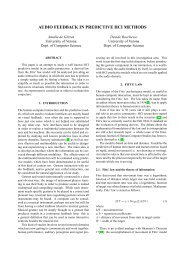novars research centre, university of manchester, uk. studio report
novars research centre, university of manchester, uk. studio report
novars research centre, university of manchester, uk. studio report
Create successful ePaper yourself
Turn your PDF publications into a flip-book with our unique Google optimized e-Paper software.
NOVARS RESEARCH CENTRE, UNIVERSITY OF<br />
MANCHESTER, UK. STUDIO REPORT<br />
Ricardo Climent * , David Berezan † and Andrew Davison *<br />
*† Novars Research Centre, School <strong>of</strong> Arts Histories and Cultures, University <strong>of</strong> Manchester, UK,<br />
* ricardo.climent@<strong>manchester</strong>.ac.<strong>uk</strong>, † david.berezan@<strong>manchester</strong>.ac.<strong>uk</strong>, * andrew.davison@<strong>manchester</strong>.ac.<strong>uk</strong><br />
Abstract — NOVARS is a new Research Centre started in<br />
March 2007 with specialisms in areas <strong>of</strong> Electroacoustic<br />
Composition, Performance and Sound-Art. The Centre is<br />
capitalising on the success <strong>of</strong> Music at the University <strong>of</strong><br />
Manchester with the expansion <strong>of</strong> its existing <strong>research</strong><br />
programme in Electroacoustic Composition with a new £2.2<br />
million investment in a cutting-edgev new <strong>studio</strong>s<br />
infrastructure. This <strong>studio</strong> <strong>report</strong> covers key aspects <strong>of</strong><br />
architectural and acoustic design <strong>of</strong> the Studios,<br />
functionality and existing technology.<br />
I. INTRODUCTION<br />
The Studios were constructed by Harry Fairclough<br />
Construction Ltd, after a cutting-edge design by<br />
Cruickshank and Seward architects and acoustic design by<br />
ARUP consulting engineers. The sound system design<br />
and installation was provided by DACS-AUDIO and the<br />
project was managed by Stuart Lockwood, Estates Capital<br />
Projects Group at the University <strong>of</strong> Manchester and<br />
coordinated by David Berezan, Director <strong>of</strong> the<br />
Electroacoustic Studios at the Martin Harris Centre for<br />
Music and Drama and MANTIS.<br />
The new Studios facilities were <strong>of</strong>ficially opened in<br />
November 2007 and incorporate three large postgraduate<br />
<strong>research</strong> <strong>studio</strong>s (featuring 32-loudspeaker monitoring for<br />
sound diffusion performance <strong>research</strong> and multi-channel<br />
composition, 5.1-surround and 10-channel composition<br />
environments), a fourth multi-function <strong>studio</strong> for<br />
undergraduate teaching and work, a large 14-workstation<br />
computer cluster for teaching and student compositional<br />
work, supporting technical spaces, <strong>of</strong>fices and computer/<br />
network hubrooms.<br />
II. BACKGROUND<br />
NOVARS is named to reference and celebrate the<br />
seminal work by Francis Dhomont (Novars). In his own<br />
words 'a reversed version <strong>of</strong> Ars Nova' - New Art, New<br />
Science. Staff and postgraduate student <strong>research</strong> areas<br />
range from acousmatic composition to machine<br />
musicianship, sound spatialisation, performance practice,<br />
live interactive systems and cross-disciplinary projects.<br />
In education areas, NOVARS is supporting and<br />
reinforcing an existing well-integrated music pathway at<br />
the University <strong>of</strong> Manchester, both at Postgraduate and<br />
Undergraduate levels, merging areas <strong>of</strong> electroacoustic<br />
composition, instrumental composition and music theatre;<br />
including experimental and contemporary performance<br />
practice. An added value to the NOVARS <strong>research</strong> focus<br />
is the strength <strong>of</strong> the School's performance programme<br />
and the joint pathway between Music and the RCNM<br />
(Royal Northern College <strong>of</strong> Music). Accessibility to highclass<br />
performers in residence makes the environment<br />
extremely appealing for composers willing to experiment<br />
on extended techniques, chamber groups or large scale<br />
instrumental forces in combination with new music<br />
technologies.<br />
III. STUDIO DETAILS<br />
A. General Design Features<br />
The massing <strong>of</strong> the elevational treatment <strong>of</strong> the building<br />
is in direct response to Manchester City Planners desire<br />
to improve the visual expression along Bridgeford<br />
Street, where the <strong>studio</strong>s were built. The variety <strong>of</strong><br />
contrasting materials that have been used separate the<br />
different functional and circulation elements <strong>of</strong> the<br />
building, and improve the visual form <strong>of</strong> the frontage.<br />
Figure 1. Façade <strong>of</strong> the building hosting the NOVARS Research<br />
Centre<br />
The corner <strong>of</strong> the building is also a key site feature,<br />
further enhancing the external appearance <strong>of</strong> the urban<br />
block. A sharp angular corner was incorporated with a<br />
pronounced overhang and the corner is also accentuated<br />
by steeply raking the zinc cladding out in this direction.<br />
B. Acoustic Considerations by ARUP<br />
To reduce the effect <strong>of</strong> noise contamination both to the<br />
isolated internal <strong>studio</strong>s and to the adjoining street and<br />
neighbouring buildings, the air handling plant is<br />
attenuated and contained within the ground floor plant<br />
room with no externally mounted condensers or<br />
equipment. The building utilises chilled beams to cool the<br />
Studio spaces. With no moving parts, the cooling beams<br />
are extremely low noise. Attenuators were also installed in<br />
the main supply and return ductwork to the ventilation<br />
plant to prevent any noise breakout.<br />
The nature <strong>of</strong> the occupancy requires that the <strong>studio</strong>s<br />
are lobbied with acoustic doors and isolated structures<br />
within the building envelope. Sound incursion is therefore<br />
optimally reduced to a practical minimum. Three internal<br />
acoustic pods were constructed using slabs <strong>of</strong> thick pre-
cast concrete, and are separated from the floor via rubber<br />
isolating mounts to fully sound pro<strong>of</strong> the area. The<br />
acoustic impact <strong>of</strong> the building occupancy on the site and<br />
surroundings is therefore also insignificant.<br />
C. Studio Network<br />
Using the latest Apple Mac Pro and iMac machines<br />
with Intel processors, the <strong>studio</strong>s are networked using<br />
conventional gigabit ethernet. An Xserve is used for<br />
authentication and file storage, connected to the network<br />
on four gigabit ports using 802.3ad link aggregation. This<br />
server controls access to the client machines through its<br />
own Open Directory, as well as the <strong>university</strong>-wide Active<br />
Directory system. All <strong>studio</strong> computers are housed in a<br />
central hub room to eliminate mechanical noise within the<br />
<strong>studio</strong>s themselves, with displays connected via optic fibre<br />
using Gefen DVI-to-Optical converters. Similarly,<br />
Firewire 800 and USB 2.0 are replicated in the <strong>studio</strong><br />
spaces using a combination <strong>of</strong> converters over optic fibre<br />
and standard CAT5 ethernet. The audio interfaces<br />
themselves are housed in the same space as the computer<br />
systems, with bantam/PO-style patch bays providing<br />
complete flexibility over audio routing throughout the<br />
building.<br />
D. Audio Interfaces<br />
The primary audio interfaces are Digidesign 003 and<br />
002 rack units, with the exception <strong>of</strong> Studio 1 which<br />
benefits from a Pro Tools HD2 system with a 192 I/O<br />
interface. All <strong>studio</strong>s are also equipped with MOTU<br />
828mkII interfaces for added flexibility. In the teaching<br />
cluster, 14 iMacs are available with a mixture <strong>of</strong> MBox 2<br />
Pro and MBox 2 Mini interfaces. A custom switcher<br />
allows for audio to be routed to the cluster loudspeakers<br />
from any interface; a useful feature for demonstrating<br />
work in a teaching environment. All loudspeakers are<br />
manufactured by Genelec.<br />
E. Working Spaces<br />
1) Studio One: hosts 32-channel monitoring, and<br />
incorporates a suspended loudspeaker array on a custom<br />
made ceiling grid. This <strong>studio</strong> is mainly used for<br />
compositional, multi-channel and sound diffusion<br />
performance <strong>research</strong>. There are two sound diffusion<br />
tools: The DACS custom made MANTIS 32-channel<br />
control surface with an EtherSense device (IRCAM) and a<br />
tailor made GLUION FPGA 16bit ADC (designed by<br />
S<strong>uk</strong>andar Kartadinata) with 32 analogue inputs and 68<br />
digital inputs/outputs for experimental purposes. A<br />
combination <strong>of</strong> MOTU 24io and 2408mkIII interfaces<br />
with Mac Pro computers serve the diffusion system.<br />
2) Sheila Beckles Studio: dedicated for audio in<br />
multimedia production and composition, it incorporates a<br />
5.1 Genelec monitoring system, with one Quad-core Mac<br />
Pro featuring two Dual-Core Intel Xeon processors, a 30<br />
inch Apple Cinema Display, two additional 20 inch<br />
Cinema Displays, and other equipment. This facility is<br />
mainly designed for postgraduate and staff audio visual<br />
and compositional <strong>research</strong>.<br />
Figure 2. Postgraduate students working in Studio One<br />
3) Studio Three: Studio Three: a 10-channel<br />
monitoring system for postgraduate and staff multichannel<br />
compositional <strong>research</strong>. It contains 8 + 2<br />
loudspeakers with two subwo<strong>of</strong>ers (all Genelec), one<br />
Quad-core Mac Pro featuring two Dual-Core Intel Xeon<br />
processors and other equipment.<br />
4) Studio Four: 5.1 monitoring and composition<br />
environment and also serves as a recording and teaching<br />
space, mainly for undergraduate work.<br />
5) Studio Cluster: consists <strong>of</strong> 14 new imac<br />
workstations for group teaching and guest lectures,<br />
undergraduate and postgraduate access.<br />
IV. MANTIS FESTIVAL<br />
Another key aspect <strong>of</strong> NOVARS Research Centre’s<br />
creative umbrella is its Music Festival called MANTIS.<br />
Each year MANTIS (Manchester Theatre in Sound)<br />
presents several concerts and encounters in areas <strong>of</strong><br />
electro-acoustic music and sound-art. It provides a<br />
dynamic and appealing meeting-point for composers,<br />
artists and scientists who are willing to exchange and<br />
showcase practice-led and cutting-edge computer music<br />
<strong>research</strong>. It also promotes, disseminates and performs new<br />
works from composers based at The University <strong>of</strong><br />
Manchester.<br />
The University’s Martin Harris Centre for Music and<br />
Drama is the focal point for MANTIS concert activities,<br />
featuring a large surround sound diffusion system in the<br />
Cosmo Rodewald Hall – a 350 seat concert space, which<br />
includes box-<strong>of</strong>fice and support personnel who run an<br />
average <strong>of</strong> 80 concerts and events per year. Additionally,<br />
it also has other smaller venues, such as the John Thaw<br />
Studio Theatre (a black-box space specialising in drama<br />
productions) and the seminar room G16. The core <strong>of</strong> the<br />
MANTIS System consists <strong>of</strong> a 40-Genelec loudspeaker<br />
surround setup and a custom-made s<strong>of</strong>tware and<br />
spatialisation control interface.<br />
MANTIS has run the Festival in partnership with<br />
organisations such as Sonic Arts Network EXPO and<br />
LICA (Lancaster Institute for Contemporary Arts), both in<br />
the UK, taking the festival to numerous venues in the<br />
North <strong>of</strong> England (ie. the Victoria Baths). MANTIS has<br />
featured music from several guest composers including
Jonty Harrison, Simon Emmerson, Rajmil Fischman, Pete<br />
Stollery, Rodrigo Sigal, Francis Dhomont and Gerard<br />
Bennett. In November 2008, MANTIS will be celebrating<br />
its 10th festival in 4 years with guest composers Annette<br />
Vande Gorne (Belgium) and João Pedro Oliveira<br />
(Portugal).<br />
Figure 3. Idoia Zabaleta (KLEM) dancing Drosophila by Ricardo<br />
Climent at MANTIS: South-North 2007<br />
Two very special Festival editions occurred in 2006,<br />
when MANTIS hosted guest composer Francis Dhomont<br />
for his 80th birthday and in 2007, when MANTIS<br />
celebrated the launch <strong>of</strong> NOVARS with five specially<br />
curated concerts by D. Berezan (Berezan, Bennett,<br />
Dhomont, Casken), UK (by J. Harrison), Canada (by G.<br />
Gobeil), Germany (by L. Bruemmer/F. Hein) and USA by<br />
R. Climent (with virtuoso performers Esther Lamneck and<br />
Elizabeth McNutt).<br />
The Festival has also focused on themes such as<br />
MANTIS: South-North 07, including music from Latin<br />
American composers. The first MANTIS call for pieces<br />
received 186 submissions from all over the world. The<br />
Festival has gained the sponsorship <strong>of</strong> Arts Council<br />
England; Goethe Institute, Manchester, Sheila Beckles<br />
Foundation, Embassy <strong>of</strong> Mexico, UK; Council for<br />
Cultural Affairs, Taiwan and the Secretaria de Relaciones<br />
Exteriores in Mexico.<br />
V.CURRENT AND FUTURE ACTIVITY<br />
In the first year <strong>of</strong> its operation the Centre has hosted<br />
<strong>research</strong> seminars, masterclasses, workshops and fora<br />
covering electro-acoustic composition, sound diffusion<br />
technique and practice, sensors development, analysis and<br />
interdisciplinary work. Undergraduate and postgraduate<br />
course-unit teaching and work in areas <strong>of</strong> electroacoustic<br />
composition, aesthetics and acoustics have been<br />
supported, in addition to the <strong>research</strong> <strong>of</strong> 10 PhD students,<br />
2 full-time members <strong>of</strong> academic staff and associate<br />
<strong>research</strong>ers. The KAIROS Electroacoustic Ensemble has<br />
performed in several concerts, and in 2007/08 MANTIS<br />
delivered concerts series and events in Manchester,<br />
Lancaster, Edinburgh, Brussels and Valencia. MANTIS is<br />
currently working towards a number <strong>of</strong> festival and<br />
conference events in collaboration with guest composers,<br />
artists and other institutions.<br />
A program <strong>of</strong> Research Assemblage Groups has been<br />
established by postgraduate students and academic staff.<br />
Formulated groups focus on Sound Spatialization;<br />
Aesthetics and Analysis; Dissemination, Performance and<br />
Music Musicianship; Phonography; Synthesis and<br />
S<strong>of</strong>tware and Impossible Research.<br />
NOVARS launched two Residency Schemes for Artists to<br />
undertake work in the <strong>studio</strong>s (currently open to music<br />
composers) and for Engineers and physical Scientists to<br />
procure the advancement <strong>of</strong> existing or new areas <strong>of</strong><br />
<strong>research</strong>. In 2008 NOVARS’s resident artists are: João<br />
Pedro Oliveira (Portugal) sponsored by the Calouste<br />
Gulbenkian Foundation and including the commission <strong>of</strong><br />
new work; Pippa Murphy (UK) –freelance residency- and<br />
Thomas Bjelkeborn (Sweden) sponsored by The Society<br />
<strong>of</strong> Swedish Composers and the Helge Ax:son Johnson<br />
Foundation. On the Engineering side: S<strong>uk</strong>andar<br />
Kartadinata (Germany) sponsored by the Pump Priming<br />
Fund, Manchester University, in the area <strong>of</strong> FPGAs and<br />
sensors technology; Stefan Bilbao (Canada/UK) in the<br />
area <strong>of</strong> Physical Models and Matlab and Patrick Sanan<br />
(USA) also in Physical models and Sound-art. In the next<br />
year the Centre aims to commission new creative work,<br />
continue with the organization <strong>of</strong> workshops and<br />
consolidate the efforts <strong>of</strong> the Research Assemblage<br />
Groups.<br />
VI.ACKNOWLEDGEMENTS<br />
Technical <strong>report</strong>s provided by Harry Fairclough<br />
Construction Ltd, Cruickshank, Seward architects ARUP<br />
consulting engineers, DACS-AUDIO and Estate Electrics;<br />
University <strong>of</strong> Manchester. Graphic materials <strong>of</strong> the<br />
building by Beccy Lane; Positive Image Photography.<br />
For Further details visit<br />
http://www.<strong>novars</strong>.<strong>manchester</strong>.ac.<strong>uk</strong>/


